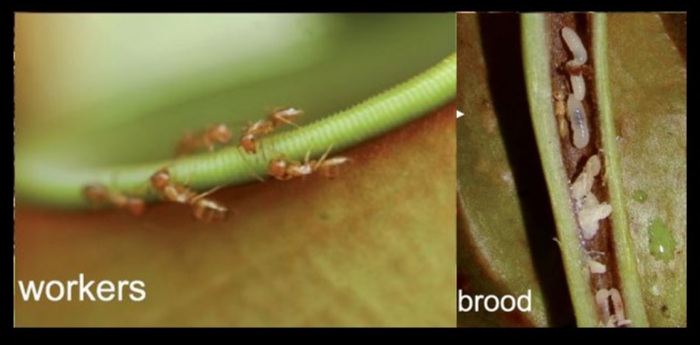As mammals, and even more so as apes, we tend to associate fangs with threats. The image of two dagger-like teeth can send chills up ones spine. Perhaps it is fitting then that a carnivorous plant from a southeast Asian island would sport a pair of ominous fangs. Friends, I present to you the bizarre fanged pitcher plant (Nepenthes bicalcarata).
This ominous-looking species is endemic to Borneo and gets its common name from the pair of "fangs" that grow from the lid, just above the mouth of the pitcher. Looks aren't the only unique feature of this species though. Indeed, the entire ecology of the fanged pitcher plant is fascinatingly complex.
Lets tackle the obvious question first. What is up with those fangs? There has been a lot of debate among botanists as to what function they might serve. Some have posited the idea that they may deter mammals from feeding on pitcher contents. Others see them as mere artifacts of development and attribute no function to them whatsoever.
In reality they are involved in capturing insects. The fangs bear disproportionately large nectaries that lure prey into a precarious position just above the mouth of the pitcher. Strangely enough, this may have evolved to compensate for the fact that the inside of the pitchers are not very slippery. Whereas other pitcher plant species rely on waxy walls to make sure prey can't escape, the fanged pitcher plant has relatively little waxy surface area within its pitchers. What's more, the pitchers are not very effective at capturing prey unless they have been wetted by rain. The fluid within the pitchers also differs from other Nepenthes in that it is not very acidic, contains few digestive enzymes, and isn't very viscous. Why?
Worker ants cleaning the pitcher (left) and an ant brood chamber inside of the pitcher tendril (right). Photo by Bazile, V., J.A. Moran, G. Le Moguédec, D.J. Marshall & L. Gaume 2012. A carnivorous plant fed by its ant symbiont: a unique multi-faceted nutritional mutualism. PLoS ONE 7(5): e36179. doi:10.1371/journal.pone.0036179 licensed under CC BY 2.5
The answer lies with a specific species of ant. The fanged pitcher plant is the sole host of a carpenter ant known scientifically as Camponotus schmitzi. The tendrils that hold the pitchers themselves are hollow and serve as nest sites for these ants. Ant colonies take up residence in the tendrils and will hunt along the insides of the pitchers. In fact, they literally go swimming in the pitcher fluid to find their meals!
This is why the pitcher fluid differs so drastically from other Nepenthes. The fanged pitcher plant actually does very little of its own digestion. Instead, it relies on the resident ant colony to subdue and breakdown large prey. As a payment for offering the ants room and board, the ants help the plant feed via the breakdown of captured insects (which are often disposed of in the pitchers) and the deposition of nitrogen-rich feces. Indeed, plants without a resident ant colony are found to be significantly smaller and produce fewer pitchers than those with ants. The ants also protect and clean the plant, removing fungi and hungry insect pests.
Sadly, like many other species of Nepenthes, over-harvesting for the horticultural trade as well as habitat destruction have caused a decline in numbers in the wild. With species like this it is so important to make sure you are buying nursery grown specimens. Never buy a wild collected plant! Also, if you are lucky enough to grow these plants, propagate them! Only by reducing the demand for wild specimens can we hope of curbing at least some of the poaching threats. Also, what better way to get your friends into gardening than by sharing with them amazing carnivores like the fanged pitcher plant.
Female flowers







